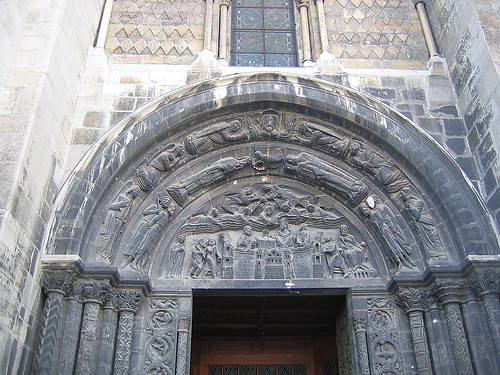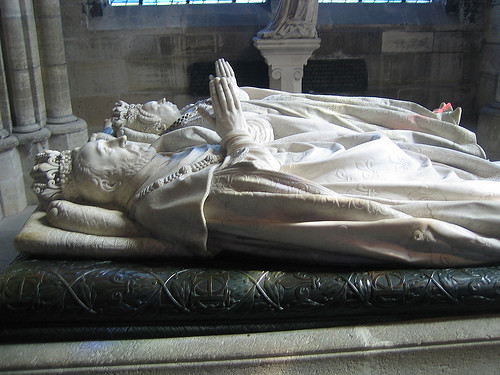Cathédrale royale de Saint-Denis, or simply Basilique Saint-Denis, is a very old and important cathedral in the outskirt of Paris, with its choir completed in 1144, considered to be the first medieval Gothic architecture ever built. Its rose window at the west portal was probably the first example of a rose window within a square frame, which was to become a dominant feature of the Gothic facades of northern France. Historically, the church was the burial place of the French Kings, with nearly every king from the 10th to the 18th centuries being buried there, plus many from previous centuries, including the beheaded Louis XVI and his queen, and the crystal urn containing their son, the young Dauphin's mummified heart. In addition, this abbey served as the locale for the coronation of many French queens.
In 2008, I visited this ancient place and was deeply impressed by the stern-looking cathedral and the historical and cultural sediments accumulated there. The medieval building itself was the most impressive sight and particularly those relief adorned many portals. One of the my favorites was the relief above the right portal, depicting Christ administers the Eucharist to Saint Denis and his companions on the eve of the Martyrdom, in the middle of the tympanum while the executioners closing in from both sides.
The line drawings like clean contours of the mythical figures, archaic looking, ancient, emaciated and strange, formed a scene of acceptance and dignity, rather than terrifying or terrified. The martyrdom was never more serene and becalming.

Christ administers the Eucharist to Saint Denis and his companions on the eve of the Martyrdom, Basilique de Saint-Denis (Portail droit)
There were many sculptures, mostly burial monuments, inside the vast basilica, from humble to massive. I found the effigies of Henry II of France (31 March 1519 – 10 July 1559) and his queen Catherine de' Medici (13 April 1519 – 5 January 1589) the most memorable - they were lying in full regalia, self-important and forbidding, yet held their hands in devote supplication, at once vulnerable and noble. Such dichotomy always made the work much more interesting and even these two somewhat off putting nobles appealing.

Tombs of Henry II of France and Catherine de' Medici
My Favorite Museum Collection Series
>> My Favorite Museum Collection Series 68: My Favorite Sculptures at Château de Versailles
<< My Favorite Museum Collection Series 66: My Favorite Paintings at Église Saint-Sulpice, Paris
>> My Favorite Museum Collection Series 68: My Favorite Sculptures at Château de Versailles
<< My Favorite Museum Collection Series 66: My Favorite Paintings at Église Saint-Sulpice, Paris
Other Related posts on Art · 文化 · Kunst:
- Grand Palais in Paris
- Musée de Cluny - Musée national du Moyen Âge, Paris
- Travel Inspired Paintings
- Get Ready for the Treasures from Musée d’Orsay
- Picasso: Masterpieces from the Musée National Picasso, Paris - De Young Museum, San Francisco
- Birth of Impressionism at De Young Museum, San Francisco





No comments:
Post a Comment